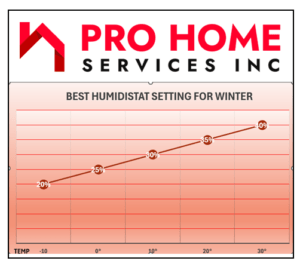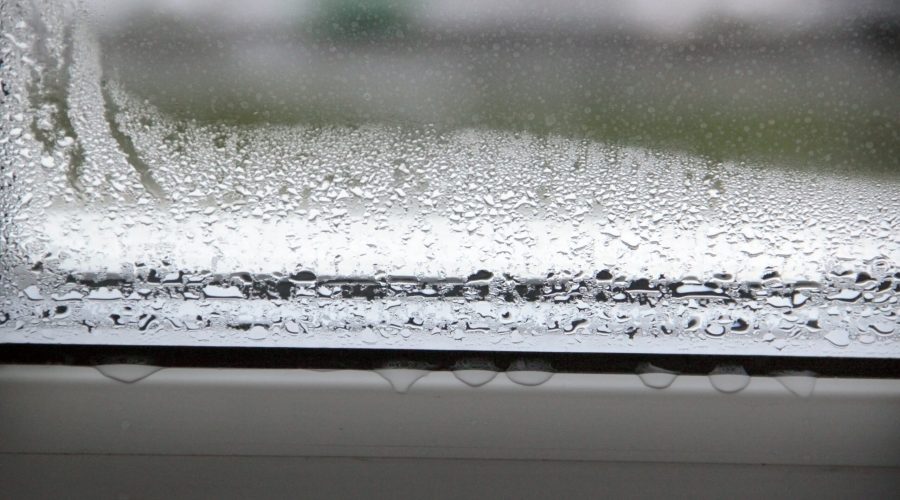When homeowners think about winter’s effects on their home, they often focus on visible challenges such as snow-covered driveways, icy walkways, and the toll the cold takes on their landscaping or gutters. Yet, another hidden winter culprit—unregulated humidity levels—can cause problems that are equally damaging. High humidity, if left unchecked, can silently wreak havoc on your home’s interior and your family’s health. This makes setting your humidistat correctly during the colder months a crucial task for homeowners.
Why is Setting Your Humidistat in Winter Important?
A whole-house humidifier is an excellent investment for maintaining the ideal humidity level in your home. During winter, the air becomes extremely dry, leading to various discomforts such as dry skin, irritated eyes, and even throat soreness. You might also notice an increase in those annoying static electricity shocks when touching a doorknob or walking across a carpet.
Dry air doesn’t just cause physical discomfort; it’s also been linked to the spread of illnesses. Research suggests that viruses like the common cold, flu, and even COVID-19 thrive in low-humidity conditions, as dry air keeps respiratory droplets suspended longer. Adding moisture to the air through a humidifier can help mitigate these risks and create a more comfortable living environment.
The key to achieving these benefits lies in your humidistat. This device monitors and regulates the humidity levels in your home. While dry air can harm your health, too much humidity can be just as harmful to your home, causing structural damage and fostering mold growth. Striking the right balance with your humidistat is essential.
Signs of Setting Your Humidistat Too High
Most experts recommend maintaining your home’s humidity level between 30% and 50% throughout the year. However, during winter, this range can fluctuate depending on outdoor temperatures. Setting your humidistat too high can result in excessive moisture, leading to various issues:
Condensation on Windows: Persistent condensation on glass surfaces can lead to wood rot, mold, and mildew growth on window sills.
Mold and Mildew Growth: High humidity creates an ideal environment for mold and mildew to thrive. Look for black or green spots on furniture, walls, or soft furnishings like carpets and curtains.
Peeling Paint and Wallpaper: Excess moisture can cause paint and wallpaper to peel, ruining your interior finishes.
Structural Damage: Moisture penetration into walls can weaken building materials, leading to long-term damage.
To avoid these problems, it’s essential to find a balance when setting your humidistat during winter.
How to Set Your Humidistat Based on Outdoor Temperatures
Winter air is naturally drier, which might tempt you to crank up your humidistat. However, it’s crucial to adjust the settings based on the outdoor temperature to prevent excessive moisture indoors. A good rule of thumb is to lower the humidity level as outdoor temperatures drop. For example:
At 20°F outside, aim for a humidity level of 35%.
At 10°F, reduce it to 30%.
At 0°F or below, keep it between 25% and 30%.
 Using this guideline ensures your home remains comfortable while minimizing the risk of condensation and moisture-related damage. Keep an eye on your windows; if you notice persistent fogging or water droplets, it’s a sign to lower your humidistat setting.
Using this guideline ensures your home remains comfortable while minimizing the risk of condensation and moisture-related damage. Keep an eye on your windows; if you notice persistent fogging or water droplets, it’s a sign to lower your humidistat setting.
Benefits of Maintaining Proper Humidity Levels
Maintaining proper humidity levels isn’t just about preventing damage to your home—it’s also about creating a healthier and more comfortable living space. Here are some additional benefits:
Improved Air Quality: Balanced humidity levels reduce allergens like dust mites and mold spores, making the air safer for those with respiratory issues.
Comfortable Skin and Eyes: Proper humidity prevents dry, itchy skin and alleviates eye irritation caused by overly dry air.
Better Sleep: Humid air can reduce snoring and improve breathing, leading to more restful sleep.
Energy Savings: Humid air feels warmer, allowing you to set your thermostat slightly lower without sacrificing comfort.
The Role of Maintenance in Humidity Control
In addition to setting your humidistat correctly, regular maintenance of your humidifier and HVAC system is essential for consistent performance. Check your humidifier’s water panel or filter monthly during winter, and replace it as needed to ensure optimal functionality. Cleaning your humidifier prevents the buildup of mineral deposits and bacteria, which could compromise air quality.
Don’t forget about your home’s insulation and ventilation systems. Proper insulation helps regulate indoor humidity, while good ventilation prevents excess moisture from accumulating in areas like bathrooms, kitchens, and basements.
Tips for Dealing with Humidity-Related Issues
If you’ve struggled with high humidity in the past, here are some practical steps to address common problems:
Install Exhaust Fans: Use fans in high-moisture areas like kitchens and bathrooms to remove excess humidity.
Seal Air Leaks: Gaps around windows and doors can let cold air in, causing condensation. Sealing these gaps improves energy efficiency and reduces moisture buildup.
Invest in a Dehumidifier: In cases where your home tends to stay humid despite adjustments, a dehumidifier can help balance moisture levels.
Monitor Humidity Levels: Use a hygrometer to measure humidity throughout your home and adjust your humidistat as needed.
Challenges of Midwest Winters
Here in the Midwest, winter weather is unpredictable. Temperatures can swing from below zero one day to above freezing the next. These fluctuations make setting your humidistat a moving target, requiring constant adjustments. Rapid temperature changes can also cause your home’s materials to expand and contract, potentially leading to cracks and other damage.
By staying vigilant and proactive, you can minimize the effects of these challenges. Regularly monitor your home’s humidity levels and adjust your humidistat as needed to maintain a safe and comfortable environment.
When It’s Time for Window Replacement
If your windows have suffered from high humidity over the years, resulting in rot, peeling paint, or constant condensation, it may be time to consider replacements. Modern windows are designed to improve energy efficiency and reduce condensation, helping you maintain proper humidity levels more effectively.
At Pro-Homes, we specialize in window replacements that stand up to the harsh Midwest climate. Our expert team can evaluate your home and recommend solutions tailored to your needs. Contact us at 331-259-8882 for a free in-home estimate and take the first step toward a healthier, more comfortable home.
Conclusion
Setting your humidistat correctly in winter is more than a convenience—it’s a necessity for protecting your home and ensuring your family’s well-being. By understanding the importance of proper humidity control, adjusting your settings based on outdoor temperatures, and maintaining your equipment, you can enjoy a cozy, damage-free home all winter long. Don’t wait for issues to arise; take control of your indoor environment today.

